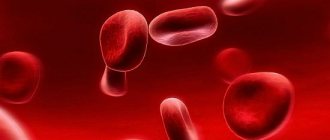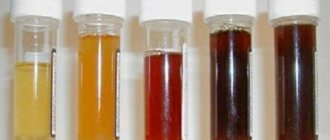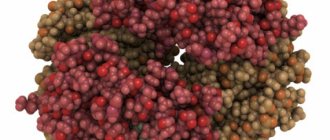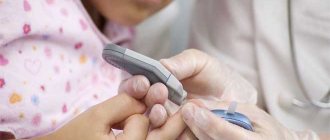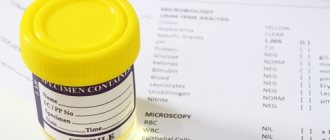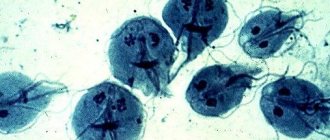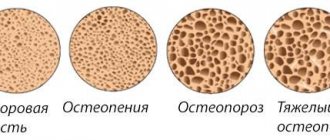A general or clinical urinalysis (abbreviated as CAM) is a well-known laboratory test of urine excreted by the human kidneys. As part of the study of biomaterial, its organoleptic, physico-chemical, biochemical and microbiological analysis takes place, as well as microscopic examination of the sediment.
In our article you will learn how to prepare for the procedure so that a general urine test in children shows reliable results. Also, in the article you will find a table that contains a breakdown and norms of OAM indicators and what deviations from established standards indicate.
Purpose of urine test in newborns
The information carried by urine contains data about the functioning of the internal organs of the newborn. Urine analysis in a child, the decoding table contains not only the characteristics of the material, but also the range of their norms. Therefore, if the conclusion from the laboratory falls into the hands of the mother, she will be able to compare the values of her baby’s urine with what they should be in a healthy child.
If the analysis shows deviations from normal values, the doctor will prescribe a more detailed examination to clarify the diagnosis. Using a simple and painless diagnostic method, the doctor can identify:
- renal failure of the newborn;
- striated muscle injuries;
- liver diseases;
- the presence of suppuration of the urinary tract;
- filaria worm infestation;
- diabetes;
- urinary tract infections;
- dehydration;
- malignant tumors;
- thyroid diseases.
This is not a complete list of diseases that a general urine test (UCA) can help identify. The need to submit the material at the age of 1 month is due to the benefits of early diagnosis of any disorders in the functioning of internal organs. Advanced diseases require a lot of effort and significantly reduce the chances of recovery.
Research in the laboratory
Need to know! Identifying abnormalities in the early stages significantly increases the chances of recovery.
Microscopy
This is the study of urine sediment under a microscope. To do this, it is centrifuged and the material is applied to the surface of a glass slide. To decipher this study, you need to know the adequate limits of the content of the main biological cells in the urine.
This information can be reflected in the table as follows.
| Item name | Limit numbers and violations |
| Red blood cells (BLD). | When assessing the indicator, age must be taken into account. Infants normally do not have red blood cells in their urine. Upon reaching 12 months, detection of 1 or 2 cells in the field of view is allowed. At an older age, the number is three units. Exceeding the limits indicates hematuria. This condition may be a symptom of kidney damage and urinary tract injury. |
| Leukocytes (LEU). | In infants who do not have abnormalities, the analysis will show the absence of these elements or the presence of up to 3 in the field of view. For girls older than one year, the maximum permissible parameter is 10, for boys 7. For adolescents, the value should not exceed 6. An increase in the number of leukocytes is a sign of inflammation. The focus may be in the urinary system or kidneys. Sometimes the cause is poor hygienic preparation for the procedure. |
| Bacteria. | They are not found in the results of healthy babies. Opposite the value normally there is the inscription negative or a dash. Age does not affect the presence of bacteria in urine. Neither children five years old nor newborns should have them. When bacteria are identified, their type and degree of sensitivity to antibiotics are determined. This is necessary for prescribing further antibacterial therapy. |
| Mucus (mucus). | A healthy child's urine is clear and free of impurities. There is normally no mucus. |
| Epithelium. | Various types of epithelium and its traces may be contained in small quantities in analyses. These parameters are satisfactory for any age. |
Important! To avoid unnecessary worries about shifts in one direction or another, it is not recommended to decipher urine tests in children yourself. Parents need to trust the pediatrician, who will correctly read the results and explain the reason for possible deviations.
Indications for the purpose of the study
As planned, without indications, the analysis is prescribed for delivery every month, six months and a year, as well as as part of a mandatory medical examination before entering a kindergarten, school, sports camp and other public organizations.
ECG in a child under one year old - interpretation of the cardiogram
You can receive a referral for an unscheduled urine test in the following cases:
- with long-term treatment to monitor the effectiveness of the prescribed course - the indications over time will indicate an improvement in the patient’s condition or the need to revise the chosen therapy;
- if there is a suspicion of disruption of the internal organs and hematopoietic system;
- to clarify the diagnosis if the clinical picture does not allow an unambiguous diagnosis of the disease.
Attention! Diagnosing infants should not be taken lightly. Urine helps control the development of internal organs and metabolic processes.
Decoding the results
Urinalysis is a regularly performed study of biological fluid according to the following parameters:
- color (Color);
- transparency;
- smell;
- pH or acidity;
- density (SG);
- protein (PRO);
- glucose (GLU);
- ketone bodies (KET);
- bilirubin (Bil);
- urobilinogen (UBG);
- hemoglobin;
- red blood cells (BLd);
- leukocytes (LEU);
- epithelial cells;
- casts in urine;
- salt;
- bacteria (NIT);
- mushrooms (NIT);
- parasites (NIT).
Duration of the study
A transcript of a child’s urine test can be obtained a few hours later if the material was submitted to a private laboratory. Budgetary city clinics have their own procedure for delivering the collected material to the laboratory, where the transcript, with the usual load of specialists and equipment, can also be ready in a few hours. Due to the fact that the delivery of results to the clinic has its own schedule, the doctor will receive the transcript no earlier than the next day.
What does a stool coprogram show in a child under one year old, analysis transcript
If a more detailed analysis is needed that describes additional characteristics of the urine, or the workload on the laboratory increases due to an epidemic of a disease, results may be delayed up to several days.
Interesting! Today, laboratories are equipped with modern equipment, which, instead of laboratory assistants, deciphers the composition of the material. If the level of medical technology remained unchanged, then today laboratory technicians would continue to taste urine to assess the level of acidity.
Sulkowicz test
Urologist Sulkovich (USA) has developed a method for determining the amount of calcium in urine. Indications for the study are the likelihood of developing hyper- or hypothyroidism, suspicion of sarcoidosis, increased consumption of vitamins A and D. The Sulkovich test is especially important for the timely recognition of rickets. Monitoring the level of calcium in the urine is necessary for newborns to prevent excess vitamin D, which is prescribed to prevent rickets. Express analysis is based on the interaction of a biomaterial sample with Sulkovich's reagent. Oxalic acid present in the reagent interacts with calcium salts, causing cloudiness and precipitation. The results are evaluated based on the positives, the excess of which is more than 2, indicating problems. When 4+ appears, it is necessary to conduct additional studies to clarify the diagnosis.
Only a doctor can draw conclusions based on the results of urine tests in children and laboratory studies of children’s biomaterial. Trying to make decisions on your own and determine the treatment method can lead to irreparable consequences. The main task of parents, especially in relation to infants and young children, is to follow all recommendations for the correct collection of samples for laboratory testing. It is necessary to prepare a supply of sterile containers in advance. In the morning, as soon as the child wakes up, you need to quickly wash the external genitalia, without using any improvised means, and dry with a paper towel. When the child wants to pee, take the required portion of urine.
Urine collection rules
The composition of urine and its color are significantly influenced by food. Therefore, on the eve of the test it is not recommended:
- give the baby beets (provided that the child already knows what complementary foods are, that is, over 6 months);
- do not include new foods in the diet;
- Do not eat cakes and other fatty sweets that take a long time to be processed by the digestive system.
Feces for carbohydrates in an infant - interpretation of the analysis, normal values
There is no need to eat immediately before delivery. Urine should be morning urine, collected before the first meal.
Rules for preparing dishes for submitting material:
- disposable container;
- it is sterile, so it does not need to be washed with soap before use;
- The collected material should not be stored at home, but delivered within half an hour to the collection point.
Need to know! Before collecting urine, the baby must be washed and dried.
Features of urine collection in infants
New mothers often wonder how to get urine into a clean and dry container from their newborn. The difficulty is that the baby cannot yet communicate the need, empties the bladder into the diaper, and it is impossible to predict urination. Mothers of girls experience particular difficulty, because helping a little boy get into the container is much easier.
Urinal
Fortunately for parents, there are special urinals for babies. They are polyethylene sealed bags with special neck inserts. The inserts are made with different hole shapes: for boys and girls in accordance with the anatomy of the genital organs. There is a special film on the neck, after removing which the mother will receive an adhesive plane. When in contact with the skin, it reliably fixes the urinal, protects it from leaks and holds it itself, without outside help.
There is nothing easier than gluing a urine bag to the child’s genitals, as indicated in the instructions, and just wait for the result.
Obtaining urine samples
An average urine sample can be obtained from any child who can control their urination. Cleaning the genitals and perineum with soap and water before bowel movement reduces urine contamination by urethral organisms and white blood cells.
A urine test can tell you a lot about your baby's health.
Obtaining urine for reliable biochemical testing:
- the first half of the day is most suitable for biochemical testing;
- the afternoon is more practical in the outpatient clinic.
There are four ways to obtain urine samples from young children who cannot yet control their urination:
- Urine bag: The genitals are checked, thoroughly cleaned and dried, and a self-adhesive urine bag is securely attached to them. Bag urine is not suitable for culture because contamination often causes false positive results.
- Clean urine: To obtain a fresh bubble urine sample, the child is held on the lap of an adult with the genitals exposed; the urine that comes out spontaneously after drinking the liquid ends up in a sterile container. This method gives false positive results in 5-26% of cases.
- Catheter urine: A suitable urine sample for culture can be obtained from the child by a single catheterization (ie, not from an indwelling bladder catheter).
- Suprapubic bladder puncture: This is a simple (though rarely performed), relatively non-invasive way to obtain a urine sample if pyelonephritis is suspected, especially when the patient is an infant. Vesical puncture is indicated whenever sac urine may be contaminated, such as in patients with vulvovaginitis, anogenital dermatitis, or phimosis. The puncture is most likely to be successful if the degree of bladder filling is first assessed using ultrasonography: in newborns and infants, ultrasonography increases the likelihood of obtaining an adequate urine sample from 60% to almost 97%.
A sample taken in the morning is most suitable for biochemical analysis. Urine should always be collected at the same time of day from each patient so that results are comparable across all tests. Spontaneous urine should not be stored for more than 1-2 hours at room temperature or 4 hours in the refrigerator (at 4°C) before analysis, otherwise the cells will disintegrate, the number of bacteria will increase, and the pH will rise.
Interpretation of a general urine test for an infant
If parents contact a private laboratory for a urine test, the results with a table of norms and interpretation of the infant can be obtained online. When contacting a city children's clinic, a completed document with the result will be available from your local pediatrician. To independently assess the child’s health, the data obtained will need to be compared with the values of the norm, which is different for each age.
Normal values of clinical urine analysis for children under one year of age
| Options | Values are normal | |
| For a newborn (up to 28 days) | From a month to 1 year | |
| Transparency | Transparent | |
| Color | Light, yellow | |
| Smell | Unsharp | |
| Density, g/m | 1,002-1,004 | 1,006-1,01 |
| Protein, g/l | Absent or not more than 0.002 | |
| Sugar, mmol | Absent or not more than 0.03 | |
| Bilirubin | Not detected | |
| Ketone bodies | Not detected | |
| Hemoglobin | Not detected | |
| Nitrites | Not detected | |
| Urobilinogen | No more than 10 mg/l | |
| Sediment (microscopy) | ||
| Leukocytes | None | |
| Cylinders | None | |
| Red blood cells | None | |
| Epithelial cells | Absent or no more than 5 in p/zr | |
| Bacteria | None | |
| Mushrooms | None | |
| Salts | None | |
| Slime | None | |
Physico-chemical analysis
The second stage of the study is the assessment of physicochemical parameters of urine analysis (density and acidity).
Specific gravity
The relative density (specific gravity) of urine shows the concentration of nitrogenous compounds dissolved in the biomaterial and characterizes the ability of the kidneys to excrete urine with a high concentration of waste. In children, the ability of the kidneys to concentrate urine is reduced, so the upper limit of normal for the volume of daily diuresis is greater than in adults, and the relative density of urine is less.
The appearance of glucose in a child's urine is usually associated with diabetes mellitus.
The specific gravity of urine may vary depending on the age of the child and some external factors. The normal relative density of urine in newborns is 1.002–1.020 g/ml. Then the density gradually increases and by the age of three it is 1.010–1.017 g/ml. From the age of 12, this indicator reaches normal values for an adult.
Increased urine density is caused by the presence of glucose or protein in the urine. Observed in cases of dehydration or oliguria, uric acid diathesis, blood loss, glomerulonephritis, gastrointestinal diseases accompanied by frequent vomiting and diarrhea, diabetes mellitus, circulatory failure. An increase in urine density can also be a consequence of the administration of certain medications and radiocontrast agents.
A low urine specific gravity may be a sign of diabetes insipidus, chronic renal failure, chronic nephritis, polyuria, glomerulonephritis, pyelonephritis, and heart failure. Also, a reduced specific gravity of urine may be a consequence of a lack of antidiuretic pituitary hormone, kidney damage from heavy metals, nutritional dystrophy, polydipsia, or taking diuretic drugs.
Acidity
Urine acidity (pH) is normally 4.5–8. The acidity of urine varies depending on diet, temperature changes and acid metabolism in the stomach and intestines. In infants, this indicator is closer to alkaline, which is explained by increased milk consumption. If urine for analysis is collected after a meal, it may be slightly alkalized.
A high content of leukocytes in the urine gives it a white, cloudy color and indicates the presence of inflammation of the genitourinary system.
An elevated pH level may indicate metabolic disorders, chronic renal failure, and tumors of the genitourinary system. Acidification of urine (lower pH) develops with a predominance of proteins and fats in the diet, high physical activity, fasting, and may also indicate diabetes mellitus, dehydration, diarrhea or tuberculosis. A shift in urine pH levels below or above normal may indicate the formation of stones.
Possible reasons for deviations from the norm
If the color of urine differs from the norm and has dark shades, this may indicate the following problems:
- dehydration of the body;
- gallbladder disease;
- intoxication of the body;
- the presence of hemoglobin in the urine.
An elevated pH level indicates alkalization of urine. This may be the result of the stomach not producing enough juice, liver failure or tubular acidosis.
Red blood cells in small quantities indicate the possible onset of urolithiasis, but if a significant number of them is detected, a detailed examination should be carried out for the presence of a malignant tumor of the urinary tract.
Normally, a child's urine should not contain protein. However, traces of it are allowed to be present. If, after decoding, it turns out that protein is clearly present in the urine, this indicates glomerulonephritis - a disorder of the kidney structure that prevents the organ from performing its filtering function.
The presence of bilirubin is a signal of serious liver dysfunction. An increased level of leukocytes clearly indicates inflammatory processes of the urinary tract, such as cystitis or pyelonephritis. Ketone bodies indicate dysfunction of the thyroid gland.
Important! If sugar is detected in the urine, this indicates that the level of glucose in the blood is significantly exceeded. At the same time, the analyzed material acquires a fruity aroma. This is a dangerous indicator indicating the threat of diabetes.
Organoleptic analysis
The research is carried out in several stages. The first stage is the method of organoleptic evaluation of biomaterial, in which the characteristics of urine are assessed using the senses. During the study, the volume of urine, its color, smell, transparency and foaminess are analyzed.
Volume
The daily volume of urine depends on the age of the child, the amount of liquid he drinks, water loss through sweat, natural bowel movements, and exhaled air. In children under 3 months of age, diuresis is normally relatively small, since they consume little fluid, but seems significant due to the frequency of urination.
The rate of daily urination in children under 10 years of age is calculated by the formula: 600+100×(n-1), where n is the child’s age (number of full years). When determining daily diuresis, the number of daytime and nighttime urinations is taken into account.
You can also use the table to determine the norm of daily urine volume depending on the child’s age.
| Age | Daily urine volume, ml |
| Up to 6 months | 250–450 |
| From 1 year to 2 years | 330–600 |
| From 2 to 3 years | 760–820 |
| From 3 to 5 years | 900–1070 |
| From 5 to 7 years | 1070–1300 |
| From 7 to 9 years | 1240–1520 |
| From 9 to 12 years | 1520–1670 |
| From 13 to 15 years | 1580–1700 |
| From 15 to 18 years old | 1720–1900 |
Deviation from the norm of daily diuresis in children may be a sign of a disease of the urinary system.
Excessive urine output is called polyuria. It is diagnosed by comparing the existing diuresis with the norm. Polyuria can be physiological, associated with the consumption of foods and liquids that cause increased urine production, taking diuretic medications, or hypothermia. Pathologies leading to polyuria in childhood include chronic renal failure, kidney stones, pyelonephritis, sarcoidosis, diabetes, and heart failure.
In newborns, the presence of bilirubin in the urine is allowed, since the process of excretion of bile pigments is not yet fully formed.
Nocturia is a condition when nocturnal diuresis prevails over daytime diuresis. Increased formation of night urine may be normal in children under two years of age, and less often – up to 7 years of age. From 7 to 12 years of age, nocturia occurs in only 4% of children. The appearance of nocturia may indicate heart failure, nephrosclerosis, atherosclerosis of the renal arteries, chronic glomerulonephritis, pyelonephritis, cystitis, liver cirrhosis, diabetes, pernicious anemia, thyroid diseases.
A decrease in daily diuresis (oliguria) is observed with limited drinking, increased sweating, vomiting, diarrhea, febrile illnesses, and taking certain medications. A slowdown in urine formation can be caused by nephrological diseases (glomerulonephritis, renal vein embolism, pyelonephritis, acute renal failure), hemolytic anemia, urinary tract obstruction, heart failure.
Color
The normal color of urine in children is straw yellow, lighter than in adults. In newborns it is almost colorless, in some cases in the first few days after birth it has a reddish or orange tint. Normally, the shades of urine in children range from light yellow to amber.
Normally, children's urine is very light, almost colorless.
Color changes are often associated with changes in diet, taking vitamins, and certain medications. Pale colored urine may be a sign of diabetes or kidney problems. Urine turns light brown in acute infectious processes, febrile conditions, congestive processes in the kidneys, loss of fluid with vomiting and diarrhea, cirrhosis and burns. Beer-colored urine is a sign of hepatitis, neonatal jaundice, and hemolytic anemia. An orange tint is characteristic of liver pathologies and uric acid infarction in newborns. Urine of the type of meat slop is a symptom of kidney injury, acute and chronic glomerulonephritis. With hemoglobinuria, the urine becomes dark brown (black) in color. A high content of leukocytes in the urine gives it a white, cloudy color and indicates the presence of inflammation of the genitourinary system.
A shift in urine pH levels below or above normal may indicate the formation of stones.
Smell
The urine of a healthy newborn baby does not have a distinct odor, but as it grows older, it acquires the characteristic odor characteristic of adult urine. The pungent odor of children's urine can serve as a signal of infectious inflammation of the urinary tract, diabetes mellitus, and acetonemia.
Foaminess
In healthy children, urine practically does not foam. The physiological reason for the appearance of foam can be rapid and copious urination. Foaming urine can occur due to hypothermia, dehydration, stress, allergic reactions, and the use of chemicals to clean the toilet.
Foamy urine, regardless of water balance and diet, may indicate the presence of protein in the urine, i.e. proteinuria. Causes of increased protein in the urine can be urinary tract infections, amyloidosis, diabetes, kidney failure, heart disease, rheumatoid arthritis, sarcoidosis, and anemia. Yellow foam is characteristic of jaundice.
Transparency
Fresh urine in children is clear. Its turbidity is associated with a violation of the water-salt balance. This reaction may be due to dietary habits and insufficient fluid intake. If the clouding is permanent, this may be a sign of uric acid or calcium oxalate diathesis, pyelonephritis, cystitis, or urolithiasis.
Who to contact with bad results
The leukocyte count may not have a numerical value. In case of acute manifestations of inflammatory processes, the laboratory technician indicates the abbreviation “to all visual field,” which means “to the entire field of view.” This suggests that when the specialist studied the material under a microscope, there were such a number of leukocytes that it was impossible to count.
Laboratory assistant
Parents should not guess about how to decipher the results and which doctor to contact. It is wiser to immediately go to the pediatrician with the document from the laboratory. An experienced specialist will be able to distinguish minor deviations from significant health problems. If necessary, the doctor will give a referral for examination by a specialist.
Bacteria in urine:
- infections of the urinary system (pyelonephritis, urethritis, cystitis).
Yeast The detection of yeast of the genus Candida indicates candidiasis, which most often occurs as a result of irrational antibiotic therapy.
Reference values: negative
2.6. Inorganic sediment of urine (crystals), salts in urine Urine is a solution of various salts that can precipitate (form crystals) when urine stands. Low temperature promotes the formation of crystals. The presence of certain salt crystals in the urinary sediment indicates a change in the reaction towards the acidic or alkaline side. Excessive salt content in urine contributes to the formation of stones and the development of urolithiasis. At the same time, the diagnostic value of the presence of salt crystals in urine is usually small. Increased doses of ampicillin and sulfonamides lead to the formation of crystals.
Under physiological conditions, uric acid occurs in high concentrations of urine, after a heavy meat meal, after profuse sweating.
Reference values: none
Uric acid and its salts (urates):
- highly concentrated urine;
- acidic reaction of urine (after physical activity, meat diet, fever, leukemia);
- uric acid diathesis, gout;
- chronic renal failure;
- acute and chronic nephritis;
- dehydration (vomiting, diarrhea);
- in newborns.
Laboratory examination of urine in a child
Urine is a liquid secreted by the kidneys and is a waste product of human activity. After passing through filtration and undergoing a series of transformations, it enters the bladder, and from there through the urethra is removed from the body.
Children's urine is a multicomponent solution consisting of 90-95% water and containing organic and inorganic compounds, approximately 50-55 elements, which are determined by laboratory methods. Since the composition of urine changes several times throughout the day, it is important to determine the composition of the secreted substances and the dynamics of their fluctuations. This allows you to evaluate the filtration, reabsorption and concentration abilities of the kidneys.
Attention! According to statistics, currently every third child in infancy is diagnosed with various diseases and pathologies, and has congenital malformations. A significant proportion of children are born with reduced body weight. This is why it is so important to perform regular diagnostic testing in young patients.
Possible indications for the procedure
Studying the state of urine is the simplest and easiest way to assess the general well-being of a child and obtain information about the stability of the functioning of important life support systems of the body. There are many indications for submitting urine for analysis, but at the same time there are certain reasons for prescribing it in children.
- Scheduled preventive examination. In infants, it is performed at the ages of one, three months and one year. In subsequent periods, the need for diagnostics arises every two years. It is aimed at identifying congenital structural anomalies or emerging developmental disorders.
- Diagnosis of suspected diseases of the urinary system. It is carried out if the child has painful urination, frequency of urges, a sharp and specific smell of urine, changes in transparency and color.
- Bacterial infections. It is prescribed to exclude renal complications after illnesses such as tonsillitis, scarlet fever, streptococcus and E. coli. The test is scheduled a week after recovery.
- Monitoring the effectiveness of therapy for pathologies affecting the kidneys and urinary tract organs.
- Monitoring the course of the disease. The doctor can refer you for analysis in case of various complications, protracted pathological processes, frequent acute respiratory viral infections and influenza.
The doctor must prescribe OAM before vaccination, if the baby has allergies or chronic diseases, during registration for kindergarten or school, or hospitalization in a hospital.
Key indicators and their meanings
All parameters that a doctor determines through urine analysis involve assessing its physical qualities, identifying all components present, as well as studying urinary sediment. A competent interpretation of a general urine test in children involves studying certain criteria, each of which has its own norm. For convenience, they are all combined into a system and presented in table form.
| Criterion | Meaning | Description of the norm |
| Color | Depends on the presence of pigments. Caused by the child’s diet and medications. | From straw yellow to deep amber. |
| Smell | Depends on the volatile components present in the composition. | Specific, but not harsh. Reminds me of the aroma of meat broth. |
| Transparency | Indicates the presence of sediment in urine. | Transparent, without impurities. |
| Acidity | Characterizes the percentage pH ratio. Assumes constant change. | Neutral pH=7 or slightly acidic pH=5-7 |
| Specific gravity | Depends on the composition of urine. It is considered a criterion for assessing the filtration capacity of the renal apparatus and characterizes the degree of dehydration of the body. Variable indicator. | The first days after birth – 1.008-1.018 0-6 months – 1.002-1.003 6 months-1 year – 1.006-1.009 3-5 years – 1.010-1.019 7 years – 1.008-1.021 Over 10 years – 1.011-1.025 |
| Squirrels | Organic substances consisting of a set of amino acids. | None. Up to 5 units are acceptable in newborns. |
| Glucose | A simple carbohydrate that appears in the urine due to excess levels in the blood. | Absent. May be detected after feeding the baby. |
| Bilirubin | One of the important components of bile. | Not detected. |
| Urobilinogen | A derivative of a previous substance. | Absent. |
| Ketone bodies | Products of metabolism of fats and carbohydrates. Possess toxicity. | Minor content is allowed in the case of a low-carbohydrate diet. |
| Indican | A derivative of indoxyl. | Absent. |
| Epithelium | Cells trapped in urine during collection. | A small amount. |
| Cylinders | Microparticles that are an indicator of kidney function and their filtration ability. | Not detected. |
| Bacteria | Microorganisms that penetrate urine during collection. | Not detected. |
| Red blood cells | The transport elements of blood are round red cells. | None. |
| Salt crystals | Oxalates, phosphates, urates. | May be found in breastfed infants. |
| Leukocytes | White blood cells. | None. |
| Slime | A by-product of the work of the internal shells. | Absent. |
In a general urine test, the same parameters are considered as in adults. The normative values of the studied material, which form the basis for assessing the child’s condition, vary depending on age. Therefore, interpretation of urine tests in children must be carried out taking this factor into account. The interpretation is carried out by a qualified specialist or attending physician, since only he can determine the nature of the identified abnormalities, taking into account the fact that they do not always indicate the development of pathology.
Organoleptic indicators
The first stage of the study, in which parameters are assessed using the senses. These include color characteristics, smell, transparency and quantitative indicator. Explanation of the main criteria for urine analysis in children and their deviations are indicated in the table.
| Color | A deep yellow tint indicates dehydration due to cardiac problems. Dark, almost brown, indicates pathologies of the liver and gall bladder, structural changes in these organs. A red color appears when the lower back is injured, or there is sand and stones in the kidneys or bladder. Hypochromuria in urine analysis in infants is a consequence of feeding on mother's milk. |
| Smell | A pungent aroma appears with dehydration or the development of diabetes. The smell of acetone indicates inflammation of the bladder. The aroma of rot appears with infections of the urinary system. |
| Transparency | Its loss and the appearance of turbidity indicate the ingress of epithelial cells, the presence of erythrocytes and leukocytes, and urea. |
Microscopic examination
A urine sample is examined using a microscope. At this stage, blood elements, casts and salts are identified.
| Index | Diseases | Peculiarities |
| Red blood cells | Cystitis; Viral lesions; Pathologies of the urinary system; Chemical poisoning | A small amount appears as a result of physical overexertion |
| Leukocytes | Cystitis; Pyelonephritis; Kidney pathologies; High concentration indicates decay processes | Entry occurs from the labia in girls |
| Bacteria | Infection of the urinary organs | Penetration into urine as a result of violation of the rules for collecting material |
| Salts | Urolithiasis disease | Errors in nutrition, the predominance of fatty and sweet foods |
Physicochemical characteristics
At the next stage of laboratory research, the characteristics of the child’s biological fluid are assessed: density and acid-base balance.
Specific gravity indicators are considered an indicator of kidney function and filtration capacity. Increased values of this parameter are a consequence of the following conditions:
- liver pathologies;
- diabetes mellitus;
- nephrotic syndrome;
- heart rhythm disturbances.
Decreased levels indicate decreased kidney function, dehydration, or the presence of various types of infections.
A pH value of less than 5 indicates increased acidity and, conversely, at a pH above 7 a decrease in this indicator is observed. In the first case, the causes are considered to be fluid deficiency, diabetes mellitus and excess meat in the diet. In the second case, attention should be paid to serious pathologies of the functioning of the urinary tract, the development of renal failure, and the presence of infections.
Biochemical research
The results of laboratory analysis at this stage are protein, glucose, and creatinine. urea, bilirubin and urobilinogen. The presence of the first component in urine is unacceptable in any case. The development of proteinuria can be caused by the following pathologies:
- kidney inflammation;
- allergic manifestations;
- disruption of the heart muscle;
- tumor processes.
Elevated glucose levels often indicate the development of galactosemia, diabetes mellitus, or excess sweets in the child’s diet. A deficiency of this component, on the contrary, leads to the development of ketonuria (the appearance of ketone bodies, in particular acetone). If an increased level of urobilinogen is detected, attention should be paid to the functioning of the gastrointestinal tract.
Characteristics and indicators of different types of analyzes
If a general urine test in children shows significant deviations from the norm in key indicators, the doctor may prescribe a more thorough study. There are several types of studies that are performed to differentiate diagnoses, especially if there is suspicion of the development of urinary tract pathologies.
- Urinalysis according to Nechiporenko. It is carried out during a routine examination of patients with chronic diseases of the urinary system, if formed elements are detected in the TAM - leukocytes, erythrocytes, casts, as well as protein. Among specialists, the study is called cumulative samples, since it allows one to detect pathological structures in the urine and identify hidden inflammation.
- Urine analysis according to Zimnitsky. Allows you to assess the functionality of the kidneys and is carried out according to three parameters: the daily volume of urine (diuresis), specific gravity and the balance between daytime and nighttime amounts. Diseases of the urinary tract and kidneys may be indicated by oliguria (insufficient excretion of biological fluid), nocturia (increased urination at night), as well as polyuria (excessive volume of daily urine). The latter is often caused by the child consuming large amounts of fluid.
- Bacterial culture of urine. A sterility test is prescribed to detect urinary tract infections. The analysis requires collecting an average portion of urine. Normal values are considered to be: 1.0 x 10² CFU in 1 ml of biological fluid.
- Biochemical urine analysis. The study is considered indispensable in the diagnosis of urinary tract diseases. The material collected during the day is subject to study. Based on the results, the doctor is able to evaluate the functioning of not only the kidneys, but also other structures and systems of the body. Pathological disorders can be judged by the presence in the composition of elements such as protein, glucose, ketone bodies (acetone), cylinders and other formed elements.
- Test strips. A modern, fast and convenient method for testing urine at home. It allows you to get quick results when acute pain occurs in the abdomen, lumbar region, if an inflammatory process or diabetic coma is suspected. The level of confidence is quite high. If the test is carried out correctly, glucose, ketonuria, proteinuria, and leukocyturia can be detected in the urine.
If children do not have serious pathologies or serious illnesses, the doctor will prescribe a general clinical urine test. It helps to determine the chemical composition, the presence of abnormalities and clarify the disease.
It is important to know! But in most cases, it is impossible to make a reliable diagnosis based on TAM alone. In this situation, additional laboratory tests according to Nechiporenko, Zimnitsky, Sulkovich, as well as the Amburge and Kakovsky-Addis tests are prescribed.
How to properly collect urine from a child
It is permissible to collect the analysis only in a sterile container (sold in pharmacies and costs 12-20 rubles). Do not use mayonnaise jars for this - containers that are poorly rinsed from food and soap will distort the final result.
Do not collect material for analysis in the evening: urine should be delivered to the laboratory no later than 2 hours from the moment the container is filled.
If the material is left for a longer period of time, the analysis may be unreliable due to sedimentation.
Ideally, more than 5 hours should have passed since the last urination. However, for a baby who may urinate more than 15 times per day, it is impossible to fulfill this requirement. Therefore, try to collect urine immediately after your baby wakes up.
Features and preparation:
- Transport urine carefully - frost or heat can distort the results. If you are not sure about the weather, use a thermal bag.
- The day before, do not give your child unfamiliar foods (and do not eat them yourself if the child is breastfed), and do not feed vegetables and fruits that can color the urine.
- Try to keep your baby from overheating, sweating and freezing before donating urine - all this can negatively affect the final result.
- Try to make sure that the child does not cry - the emotional state also affects the performance.
Important: you must give urine on an empty stomach. You should collect an average portion of the very first morning urination!
Types of analyzes
Poor urine test in a baby
A general urine test is based on the microscopic determination of all components that make up the biological fluid. A laboratory assistant or a special device counts elements in the field of view of the microscope.
Unfortunately, a general urine test is often not enough to make an accurate diagnosis in children. To clarify the pathological condition, the following laboratory diagnostic methods are used.
Urinalysis according to Nechiporenko. The test has advantages relative to general clinical research. First of all, we are talking about greater accuracy and information content from the procedure, because 1 ml of urine is subject to microscopic examination, and not one field of view.
The method allows you to determine the number of red blood cells, white blood cells and casts in a urine test. When they increase, the doctor can judge whether the patient has inflammatory processes, bleeding, etc.
Urine analysis according to Zimnitsky. This study is prescribed for all children with suspected dysfunction of the glomerular apparatus of the kidneys (especially the concentration function). The child needs to urinate into sterile containers at regular intervals (every 3 hours). Next, the laboratory assistant examines all 8 jars, in which the concentration of all components, the total and portioned volume of urine excreted, the ratio of daytime and nighttime diuresis, sediment density and other indicators are determined.
Culture of urine on nutrient media (bacteriological examination). It is necessary if inflammatory processes in the urinary tract are suspected. In order to establish the exact nature of the infectious agent, children's urine is inoculated onto a special medium on which bacteria can grow (a colony of microorganisms). At the same time, their sensitivity to antibacterial drugs from different pharmacological groups is assessed.
Biochemical analysis of urinary sediment (24-hour urine test). If there are metabolic diseases of different organs and systems of the body, then this study is prescribed without fail. Thanks to biochemistry, it is possible to determine the content of substances in urine such as sodium, potassium, calcium, casts, acetone, glucose and others. Normally, they are completely absent or contained in minimal quantities.
Indicator test strips. They can be purchased at the pharmacy. They are necessary for quickly identifying certain disorders in the functioning of the child’s body at home. Using these strips, you can evaluate the acidity of urine, its specific gravity, the presence of acetone, protein, calcium and other pathological components in it.
Preparing for the study
The results of a clinical urine test are quite often false. The reasons lie not only in errors in counting or decoding, but in a simple violation of the rules for collecting biomaterial and its storage. There is no special preparation for urine testing. It is enough just to normalize the child’s nutrition, drinking regime, and psycho-emotional state.
- For two days, you need to eliminate from eating all foods containing coloring pigments - vegetables, some types of berries and fruits, sweets and carbonated drinks, as well as fatty, spicy and protein foods.
- During the same period, stop taking certain groups of medications and vitamin complexes. If it is impossible to take a temporary break, you should notify your doctor in advance.
- If a child attends sports clubs, 2-3 days before the study it is necessary to stop classes and also exclude any physical activity.
- You also need to make sure that he does not experience discomfort, stress, nervous tension and mental fatigue.
Doctors advise preparing a container for a urine sample in advance. This can be a sterilized and dried glass jar or a single-use container that can be purchased at a pharmacy.
Microscopic indicators
Leukocytes.
Leukocytes indicate inflammation of the child’s urinary or genital area. Most often, their increase is observed in cystitis and pyelonephritis. The symbol “in p/z” or “in p/zr” is deciphered as in the field of view, that is, the number of cells visible when examined by a laboratory assistant under a microscope. Leukocytes perform a protective function, immediately react to inflammation and rush towards it. A very high level of leukocytes is observed during purulent processes.
Red blood cells
- These are red blood cells. In the urine there are either none at all, or only one in sight. A small amount may be the result of physical overexertion of the child. A significant increase in their number is diagnosed in cystitis, kidney and biliary tract diseases.
Bacteria.
Bacteria and fungi must be absent. If bacteria are detected, the doctor will refer you for bacterial culture. Additional research will allow us to see the whole picture of the disease.
Salt.
The presence of salts in the urine directly depends on the type of food the child eats. Often detected in infants, both during breastfeeding and during the introduction of complementary foods.
Slime.
The presence of mucus in the urine can indicate both the presence of inflammation and poor hygiene.
Such a decoding is not the basis for making an accurate diagnosis without examination by a doctor. Having a transcript of your child’s general urine test, you will know what parameters to pay attention to first of all. In addition, for additional information on some medical websites, you can fill out a table online and get information about the suspected disease.
